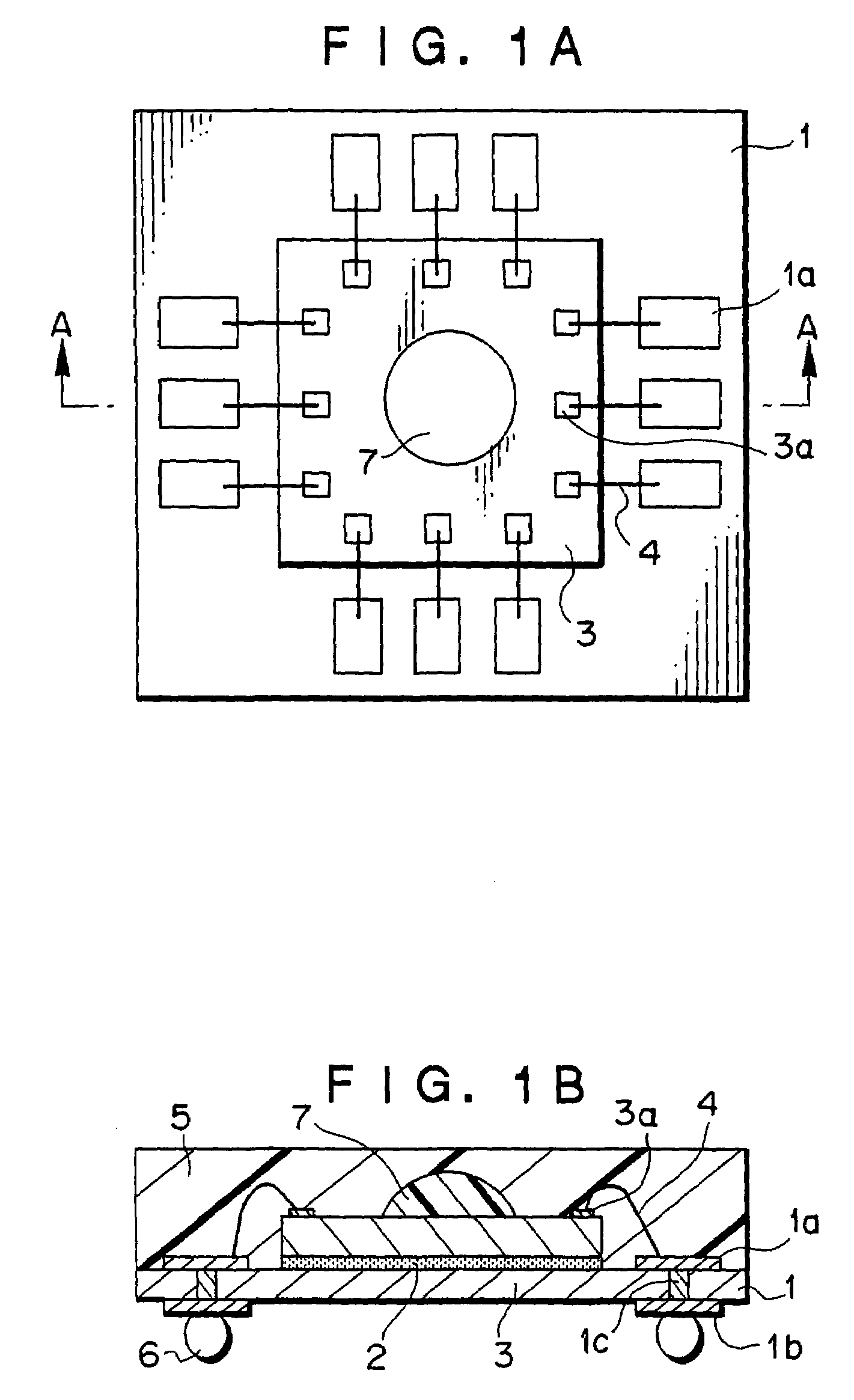Semiconductor device having contact prevention spacer
a technology of contact prevention and semiconductor devices, which is applied in the direction of basic electric elements, material analysis, other domestic articles, etc., can solve the problems of causing short-circuits, deformation of the upper metallic mold, and so as to and reduce the risk of deformation of the metal wire
- Summary
- Abstract
- Description
- Claims
- Application Information
AI Technical Summary
Benefits of technology
Problems solved by technology
Method used
Image
Examples
first embodiment
[First Embodiment]
[0035]FIGS. 1A and 1B are each a structural diagram of a semiconductor device according to a first preferred embodiment of the present invention. FIG. 1A is a plan view and FIG. 1B is a cross sectional view taken along the line A—A in FIG. 1A. In FIGS. 1A and 1B, the same members as those in FIG. 2 are denoted by the same reference numerals.
[0036]The semiconductor device shown in FIGS. 1A and 1B is that of BGA / CSP type produced by package molding / saw cutting techniques. A semiconductor element 3 (for example, an IC chip) is fixed onto a wiring substrate 1 by an adhesive agent 2. The wiring substrate 1 is formed of, for example a glass / epoxy substrate having a thickness of 0.2 mm or thereabouts and transverse and vertical dimensions of approximately 5 to 15 mm. Wiring patterns 1a and 1b are respectively formed on face and reverse surfaces of the wiring substrate 1 in the periphery thereof. Further, the wiring patterns 1a and 1b are electrically connected to each oth...
second embodiment
[Second Embodiment]
[0045]FIGS. 4A to 4C are explanatory diagrams showing a method for producing a semiconductor device according to a second preferred embodiment of the present invention. It should be noted that the same members as those in FIGS. 3A to 3C will be denoted by the same reference numerals.
[0046]In the above-described production method shown in FIGS. 3A to 3C, the contact prevention resin 7 adheres to the surface of the IC chip 3 so as to prevent the wire 4 from contacting the inner surface of the upper metallic mold 12. In comparison, in the production method shown in FIGS. 4A to 4C, an upper metallic mold 12A is used which has contact prevention protruding portions 12a formed at the inner side of the upper metallic mold at positions corresponding to respective central portions on the surfaces of the IC chips 3.
[0047]Referring now to FIGS. 4A to 4C, the method for producing a semiconductor device according to the second embodiment will be described hereinafter.
[0048]As ...
third embodiment
[Third Embodiment]
[0055]FIGS. 5A to 5C are explanatory diagrams showing a method for producing a semiconductor device according to a third preferred embodiment of the present invention. Note that the same members as those in FIGS. 4A to 4C will be denoted by the same reference numerals.
[0056]The production method shown in FIGS. 5A to 5C is different from the production method shown in FIGS. 4A to 4C in the position and dimensions of the contact prevention protruding portion formed at the inner side of the upper metallic mold.
[0057]That is, the upper metallic mold 12A shown in FIG. 4B has the contact prevention protruding portions 12a on the inner surface of the upper metallic mold 12A at the positions corresponding to the respective central portions on the surfaces of the IC chips 3 so as to prevent the wire 4 from contacting the inner surface of the upper metallic mold 12A. On the other hand, an upper metallic mold 12B shown in FIG. 5B has a warp prevention protruding portion 12b f...
PUM
| Property | Measurement | Unit |
|---|---|---|
| Height | aaaaa | aaaaa |
| Deformation enthalpy | aaaaa | aaaaa |
Abstract
Description
Claims
Application Information
 Login to View More
Login to View More - R&D
- Intellectual Property
- Life Sciences
- Materials
- Tech Scout
- Unparalleled Data Quality
- Higher Quality Content
- 60% Fewer Hallucinations
Browse by: Latest US Patents, China's latest patents, Technical Efficacy Thesaurus, Application Domain, Technology Topic, Popular Technical Reports.
© 2025 PatSnap. All rights reserved.Legal|Privacy policy|Modern Slavery Act Transparency Statement|Sitemap|About US| Contact US: help@patsnap.com



